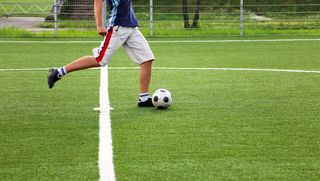Soccer and low vision
Learn about the different ways soccer can be adapted for low vision.

Summary
Soccer, or football, is a great community sport loved across Australia. But did you know there are also versions and leagues of soccer which are designed for players with low vision? Read more to find how you, and your family and friends, can start playing.
Blind football (soccer) is played by athletes who are blind or vision impaired. There are two formats of the game:
- Blind soccer (B1).
- Vision impaired/partially sighted football (B2/B3).
How it works
Vision impaired/partially sighted soccer (B2/B3) is played by athletes who are vision impaired using futsal rules with minor modifications. An audible ball which makes a rattling noise is used, allowing players to locate it by sound.
Blind soccer (B1) is an internationally recognised sport at the Paralympics, played outdoors by athletes who are blind or partially vision impaired with an audible ball.
A football match lasts 50 minutes with two halves of 25 minutes each and a 10-minute half time in between. The winning team is the one that scores the most goals during a match.
Field
The field is 40 m x 20 m, with side kickboards to keep the ball and players on the pitch, as well as a ball with bells inside of it to make it audible and easier to locate for the players.
Teams
There are two teams of five: four outfield players and a goalkeeper.
Blindfolds/Masks
The athletes who are inside the field of play wear blindfolds or a mask to guarantee equality among the players, however, the goalkeeper can be fully or partially sighted.
Vision classification
Partially sighted/vision impaired football (B2/B3) is played by athletes who have low vision, and the rules are similar to futsal with particular attention towards ensuring equal lighting on the court and utilising a futsal ball that provides good contrast with the playing surface.
B2 vision impairment (as a guide only) has the ability to recognise objects up to a distance of two metres, visual acuity ranges from below 2/60 with best corrected vision; and/or visual field of less than ten degrees diameter.
B3 vision impairment (as a guide only) can recognise contours between 2 and 6 metres away. Visual acuity ranges from 2/60 – 6/60 with best corrected vision; and/or visual field of more than ten degrees and less than forty degrees diameter.
Blind football (B1) is played outdoors by athletes who are totally blind. There are two teams of five: four outfield players and a goalkeeper. For blind football, outfield athletes must be B1, which as a guide only, means athletes are blind and have no light perception in both eyes. Impairment of the eye structure, optic nerves or pathways, or vision area of the brain, results in a loss of vision in both eyes.
Find a location near you
There are also state based programs which are coordinated by partnerships between state based blind sport and football organisations, with Australian Blind Football providing support and advice through initial implementation and throughout their development. To learn more about soccer in your state please visit the links below:
Always speak to your GP and eye care professional about the best treatment options for you.
Did you find this article helpful?
Share your thoughts and help us make our resources better for everyone.
Enjoying the content?
Start building your profile to access personalised support, resources, and tools tailored to your eye health journey.

